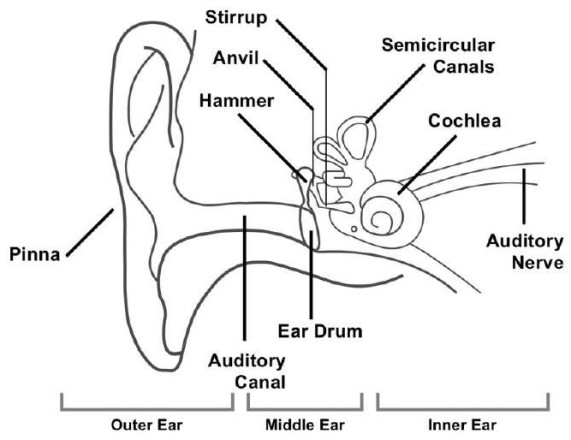
- Hearing
- Detecting changes in the positions of the body to bring about balance and posture
The Outer Ear
- This consists of an outer flap, the pinna which is made up of cartilage.- The function of the pinna is to catch and direct sounds.
- The external auditory canal is a tube through which sound travel.
- The lining of the tube secretes wax, which traps dust particles and microorganisms.
- The tympanum is a membrane stretching across the inner end of the external auditory canal.
- The tympanum vibrates when it is hit by sound waves.
The Middle Ear
- This is a chamber containing three small bones called the ear ossic1es, the malleus, incus and stapes.- The three ossic1es articulate with one another to amplify vibrations.
- The vibrations are transmitted from the tympanum to the oval window.
- At the end of the chamber is a membrane called the oval window.
- When the tympanum vibrates, it causes the ear ossic1es to move forwards and backwards.
- This causes the oval window to vibrate.
- The Eustachian tube connects the middle ear to the pharynx.
- It allows air to get in and out of the middle ear, thus equalising the pressure between the inside and the outside of the tympanum.
The Inner Ear
- This consists of a series of chambers filled with fluid.- It comprises the cochlea and semi¬circular canals.
- Cochlea is a coiled tube that occupies a small space and accommodates a large number of sensory cells.
- The cells are connected to the brain through the auditory nerve.
- They detect vibrations which lead to hearing.
Hearing
- The sound waves set the tympanum vibrating and are transformed into vibrations.- The vibrations are transmitted to the oval window by the three ossicles.
- Vibrations of the oval window cause the fluids inside the cochlea tube to vibrate.
- The membranes inside the cochlea have sensory cells which change the sound vibrations to nerve impulses.
- These are transmitted to the brain through the auditory nerve.
- Hearing is perceived in the brain.
Balance and posture
The semi-circular canals.- There are three semi-circular canals in each ear.
- They are situated at right angles to each other and each one is sensitive to movement in a different plane.
- They are filled with fluid and each has a swelling called the ampulla at one end.
- Inside the ampulla are sensory cells.
- Balance and posture are detected by these cells.
- Movement of the head in a given direction causes the fluid to move the hairs on sensory cells.
- This transmit impulses to the brain through the auditory nerve so that the movement is registered.

